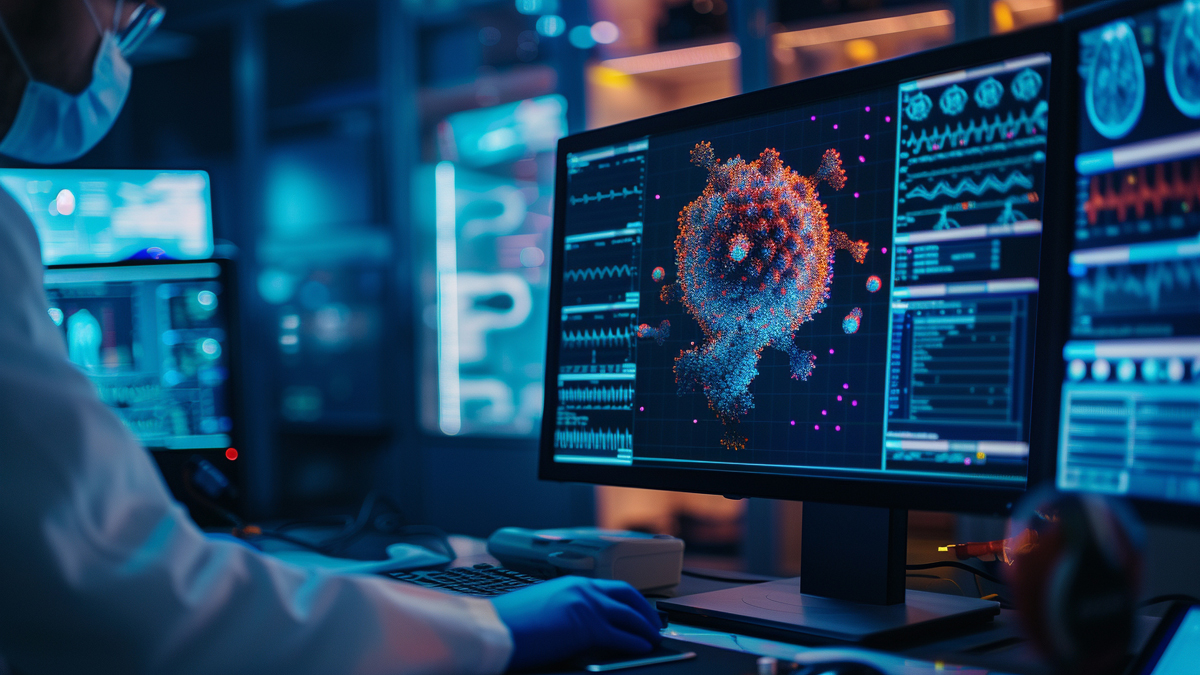Artificial intelligence (AI) has penetrated key sectors, including healthcare, transforming the detection, diagnosis, and treatment of diseases. Pathology is a promising medical field that is embracing AI. Traditionally, pathologists examined tissues, cells, and fluids under a microscope to study diseases. This human skill is crucial, but the volume of cases, the complexity of diseases, and subtle variations in tissue morphology make it more challenging. AI augments pathologists, not replaces them. By interpreting pathology slides faster, more accurately, and more consistently, AI helps reduce diagnostic errors and improve patient outcomes. As healthcare seeks to combine human expertise with machine efficiency, AI in pathology represents a significant step forward in improving diagnostic accuracy and reliability.
AI in Modern Pathology:
Pathology AI uses deep learning algorithms to analyze high-resolution digital images of tissue samples. These algorithms are trained on tens or millions of labeled images. While manual analysis can miss trends, anomalies, and subtle features, AI systems can learn from these samples. This capability is crucial for complex cases with subtle tissue changes. AI algorithms can identify problems in pathology specimens, generate probability scores, and provide pathologists with diagnostic recommendations. This approach can reduce the number of missed diagnoses and provide a second layer of verification for important decisions, such as cancer detection. AI and pathologists can collaborate and leverage each other’s capabilities to improve diagnostic accuracy.
Improving Early Disease Detection:
AI’s ability to detect diseases early is a significant advancement in pathology. Early diagnosis can improve survival and treatment outcomes for many diseases, including cancer. AI systems can detect subtle changes in cell structure, size, and arrangement that may indicate disease before symptoms appear. AI-driven systems can detect breast cancer in histology specimens as accurately as pathologists. AI can also help identify precancerous tissue lesions, enabling earlier treatment. Early identification can improve patient outcomes and reduce healthcare costs by decreasing the need for expensive therapies.
Reducing Diagnostic Errors:
Pathology diagnostic errors can delay or alter treatment plans. While human pathologists are indispensable, they can suffer from fatigue, cognitive biases, and visual impairments. AI improves the accuracy and consistency of assessment. Trained machine learning algorithms can accurately analyze slides without time or workload constraints. AI can also compare cases against vast historical datasets in seconds, ensuring the diagnosis of rare diseases. AI can reduce the number of false negatives and false positives, enabling pathologists to reach more reliable and accurate conclusions, improving patient outcomes, and reducing misdiagnosis.
Improving Workflow Efficiency:
AI transforms the speed and accuracy of pathology services. Traditional slide analysis and interpretation are time-consuming, especially in high-volume hospitals and diagnostic centers. AI can quickly screen large volumes of digital slides and identify the most suspicious cases for pathologist review. Triage prioritizes urgent cases while maintaining the quality and integrity of routine analyses. Telepathology enables pathologists to use AI-generated insights to evaluate and confirm diagnoses. The technology could be a game-changer for rural and remote areas lacking specialized pathology services.
Using AI for Accurate Cancer Diagnosis:
Cancer diagnosis is one of the most challenging tasks in pathology due to its diverse forms, stages, and subtypes. AI technology is proving successful in this field by detecting subtle differences in tissue patterns between benign and cancerous cells. AI-supported systems have surpassed human experts in breast, lung, prostate, and skin cancer. AI can also quantify tumor size, grade, and margin to inform treatment planning. This scientific, data-driven approach reduces subjective interpretation and makes diagnosis standardized and reproducible across laboratories and institutions. AI findings, combined with genetic profiles and clinical history, can yield personalized treatment plans.
The Future of AI in Pathology:
Further developments in AI technology are expected to make an even greater contribution to pathology. With improved algorithms and datasets, AI systems will provide more nuanced insights. By integrating imaging and genomics to gain a more complete picture of patient health, multidisciplinary precision medicine will become possible. Explainable AI will also make machine-generated diagnoses more transparent, allowing pathologists to better understand AI recommendations. Regulators have also recognized the potential of AI in pathology and, guided by safety and ethical guidelines, are enabling its widespread adoption. Despite limitations such as data privacy, algorithmic bias, and implementation costs, AI in pathology has the potential to improve diagnostic accuracy and efficiency.
Conclusion:
AI in pathology has revolutionized medical diagnosis. Improving pathologists’ skills has led to improved diagnostic accuracy, earlier detection, fewer errors, and greater workflow efficiency. The ultimate result is more accurate, consistent, and patient-centered disease diagnoses. AI doesn’t replace human judgment but rather complements it, combining human expertise with the speed and precision of machine intelligence. As AI tools develop and are integrated into clinical practice, patients worldwide will benefit from faster diagnoses, more effective treatments, and better medical outcomes. While technologists, physicians, and regulators must collaborate, AI in pathology holds the promise of a future where smarter, data-driven medicine delivers the highest accuracy, lowest error rates, and life-saving results.
FAQs:
1. Can AI replace pathologists?
AI supports pathologists but doesn’t replace them. It assists medical professionals in making final decisions, improving accuracy and efficiency.
2. Can AI accurately detect disease in pathology slides?
Research suggests that AI can match or even surpass pathologists in detecting cancer, although human oversight is still required.
3. What are the key challenges to implementing AI in pathology?
Large and diverse datasets, algorithmic bias, high implementation costs, and privacy and ethical compliance all pose challenges.
4. Can AI accelerate pathology diagnoses?
By pre-screening patients and prioritizing urgent follow-up examinations, AI can significantly reduce the analysis time for pathology specimens.
5. Are hospitals using AI in pathology?
Yes, many hospitals and diagnostic laboratories worldwide are using AI-supported pathology tools for cancer diagnosis and workflow optimization.




